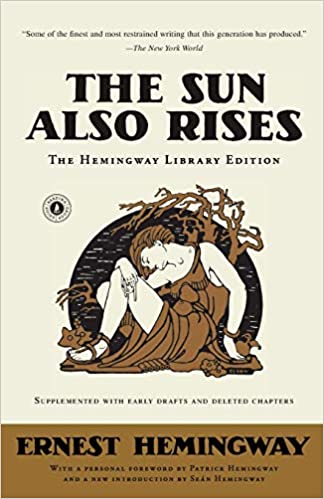
The Sun Also Rises by Ernest Hemingway is a 1926 novel famously known as the definitive “Lost Generation” story. Far-reaching and catastrophic, World War I left Americans disillusioned and bereft of purpose, as nothing in recent memory could compare to what they had just experienced. Thus, the country entered a transitional period in culture; new, freer values, consumer products, and entertainment all caused a grating contrast with traditions of thrift and hard work. Writers of the time internalized this popular struggle and soon integrated it into their lifestyles and works, resulting in some of the most distinctly American modern fiction. In succinct, memorable prose, Hemingway transports readers back to the lavish yet deceitful 1920s, where emotions were as unpredictable and indulgent as they were destructive.
The story primarily follows a group of American expatriates who travel Europe partying and vacationing. Despite having vague backgrounds and few jobs between them, they are connected as post-war wanderers, practically burdened with free time and money to spend; they fill their days at cafes and clubs, out fishing or drinking. Our narrator, Jake Barnes, drifts in and out of their whirlwind lives, struggling individually with his love for a long-time friend, Lady Brett Ashley. The central conflict takes place around the annual bullfights in Pamplona, Spain, a setting significant for its vivid passions and violent effect on the group; it acts almost like another character itself, goading them to act with abandon. As the week-long festival progresses, each of Jake’s friends is brought to his or her own extremes and, almost inevitably, disaster strikes.
This book is a surprising instance of being neither plot- nor character-driven. In terms of major plot points, there’s few to speak of. Hemingway’s prose, however, never meanders, resulting in a sense of urgency that offsets the characters’ listless drifting. Besides describing scenes with deceptive simplicity, Hemingway also makes characters come to life in just a few lines, neatly conveying their flaws, strengths, and quirks. Even further, he is able to convey that war speaks loudly for these people; Jake and his group may have a good time together, but there’s not much substance beyond this surface. They are lost in a ravaged landscape.
Although this book is an insightful product of its time, it’s not for everyone. Most of the story’s careless, erratic characters are not likeable, and barely relatable. Hemingway’s writing can further be interpreted as overly simplistic. Its undercurrent themes are strong, however, and they pervade every scene. One of the story’s strengths is that its age doesn’t detract from its ability to speak to any young generation, who will connect with the story’s emphasis on disillusionment and the struggle to grow up.
I would recommend this book to anyone who is interested in American classics, as it is accessible and straightforward but still extremely telling and characteristic of the 1920s. As someone who reads classics both for the writing and context, I really enjoyed this book even though I wasn’t expecting to. For fans of The Great Gatsby, Hemingway’s style offers a new perspective on many of the same themes and emotions. In essence, The Sun Also Rises turns a turbulent, unfamiliar moment from the past into a story that is entertaining, understandable, and worth trying.
Checkout The Sun Also Rises from the Newport Beach Public Library.